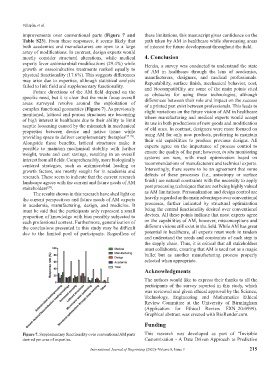Page 223 - IJB-8-3
P. 223
Villapún, et al.
improvements over conventional parts (Figure 7 and these limitations, this manuscript gives confidence on the
Table S23). From these responses, it seems likely that path taken by AM in healthcare while showcasing areas
both academics and manufacturers are open to a large of interest for future development throughout the field.
array of modifications. In contrast, design experts would
mostly consider structural alterations, while medical 4. Conclusion
experts favor antimicrobial modifications (29.4%) while Herein, a survey was conducted to understand the state
growth or osseoinductive treatments ranked equally to of AM in healthcare through the lens of academics,
physical functionality (17.6%). This suggests differences manufacturers, designers, and medical professionals.
may arise due to expertise, although statistical analysis Repeatability, surface finish, mechanical behavior, cost,
failed to link field and supplementary functionality. and biocompatibility are some of the main points cited
Future directions of the AM field depend on the as obstacles for using these technologies, although
specific need, but it is clear that the main focus overall differences between their role and impact on the success
areas surveyed revolve around the exploitation of of a printed part exist between professionals. This leads to
complex functional geometries (Figure 7). As previously slight variations on the future vision of AM in healthcare
mentioned, latticed and porous structures are becoming where manufacturing and medical experts would accept
of high interest in healthcare due to their ability to limit its use in both productions of new goods and modification
aseptic loosening caused by the mismatch in mechanical of old ones. In contrast, designers were more focused on
properties between device and native tissue while
providing space to deliver complementary therapies [77-79] . using AM for only new products, preferring to maintain
Alongside these benefits, latticed structures make it their old capabilities to produce previous designs. All
possible to maintain mechanical stability with further experts agree on the importance of process control to
weight, waste and cost savings, resulting in an overall ensure the quality of the part; however, in situ monitoring
interest from all fields. Comprehensibly, more biologically systems are rare, with most optimization based on
centered strategies, such as antimicrobial loading or recommendations of manufacturers and technical experts.
growth factors, are mostly sought for in academia and Interestingly, there seems to be an agreement that some
research. These seem to indicate that the current research defects of these processes (i.e., anisotropy or surface
landscape agrees with the current and future needs of AM finish) are natural constraints with the necessity to apply
stakeholders . post processing techniques that are not being highly valued
[29]
The results shown in this research have shed light on as AM limitations. Personalization and design control are
the current perspectives and future needs of AM experts heavily regarded as the main advantages over conventional
in academia, manufacturing, design, and medicine. It processes, further indicated by structural optimization
must be said that the participants only represent a small being the central functionality desired over conventional
proportion of knowledge with bias possibly subjected to devices. All these points indicate that most experts agree
each professional context. Furthermore, generalization of on the capabilities of AM, however, misconceptions and
the conclusions presented in this study may be difficult different visions still exist in the field. While AM has great
due to the limited pool of participants. Regardless of potential in healthcare, all experts must work in tandem
and understand the needs and constraints of each step in
the supply chain. Thus, it is critical that all stakeholders
must collaborate, ensuring that AM is used not as a magic
bullet but as another manufacturing process properly
selected when appropriate.
Acknowledgments
The authors would like to express their thanks to all the
participants of the survey reported in this study, which
was reviewed and given ethical approval by the Science,
Technology, Engineering and Mathematics Ethical
Review Committee at the University of Birmingham
(Application for Ethical Review ERN_20-0999).
Graphical abstract was created with BioRender.com.
Funding
Figure 7. Supplementary functionality over conventional AM parts This research was developed as part of “Invisible
desired per area of expertise. Customization - A Data Driven Approach to Predictive
International Journal of Bioprinting (2022)–Volume 8, Issue 3 215

